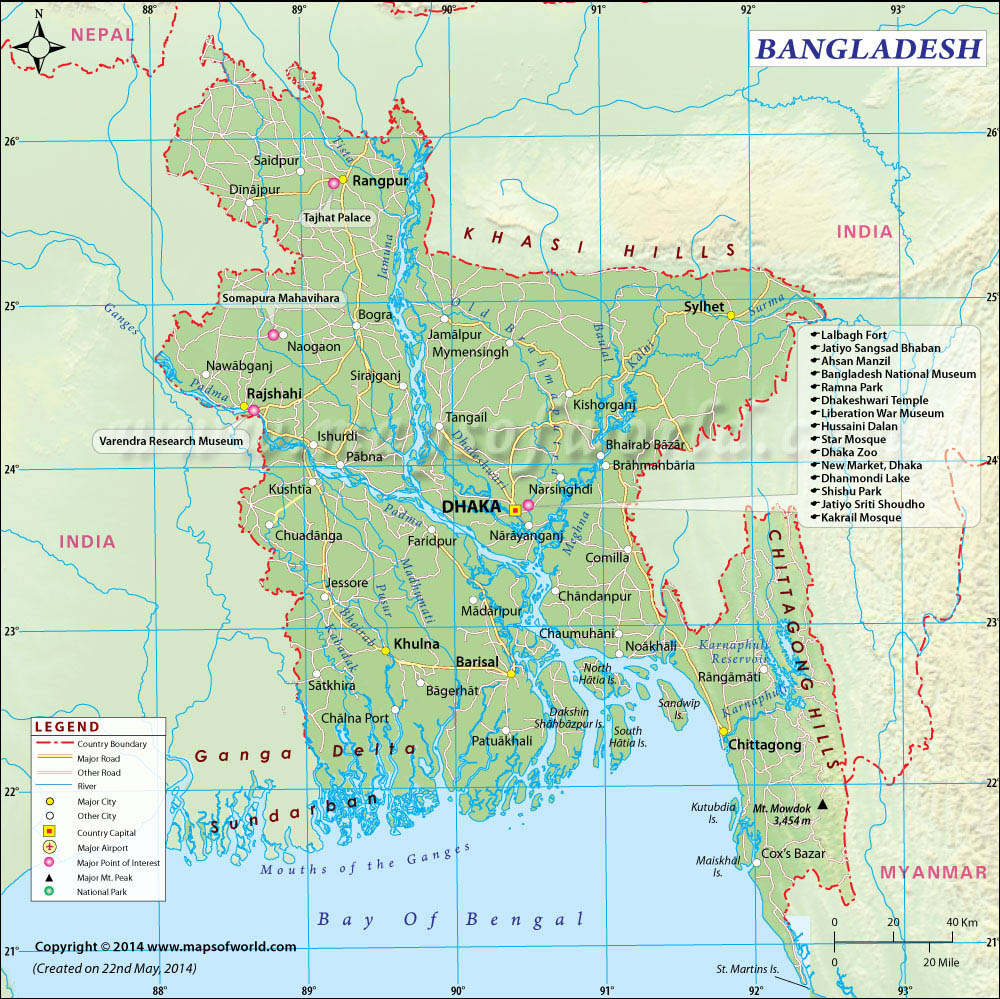About Bangladesh
Explore map of Bangladesh, Officially known as People’s Republic of Bangladesh, it is situated in South Asia and lies to the north of Bay of Bengal and bordered by India and Burma to the east and west.
| Official Name | Gana Prajatani Bangladesh (Peoples Republic of Bangladesh) |
| Capital | Dhaka |
| Population | 140.4 million |
| Area | 148,393 sq km or 57,294 sq mi |
| Currency | Taka (US$ 1=56.95) |
| Religion | Islam, Hinduism, Buddhism, Christianity |
| Literacy | 38% |
| Languages | Bangla, Chakma, Magh |
| Major Cities | Dhaka, Chittagong, Khulna |
| Climate | Tropical monsoon |
Bangladesh, formerly East Pakistan, is the second largest Muslim country in the world. The capital, Dhaka, has over 2000 mosques and is known as the city of mosques.
Physical Map of Bangladesh
The major portion of Bangladesh lies within the broad delta formed by the rivers Ganga, Brahmaputra, and Meghna rivers and constantly suffers annual floods. The only significant area of hilly terrain, constituting less than one-tenth of the country’s territory, is the Chittagong Hill Tracts District in the narrow southeastern part of the country.
Location of Bangladesh
Bangladesh is bordered on the west, north, and east by India, on the southeast by Myanmar (formerly known as Burma), and on the south by the Bay of Bengal.
Flag of Bangladesh
The flag of Bangladesh is green with a large red disk slightly to the hoist side of center. While the green colour symbolizes the lush countryside and the traditional color of Islam, the red sun of freedom.
Climate of Bangladesh
Bangladesh is warm throughout the year, with relatively little variation from month to month. January tends to be the coolest month and May, the warmest.
Flora And Fauna of Bangladesh
The flora of Bangladesh is made up of broadleaf evergreen vegetation in the hilly regions and deciduous trees, such as acacia and banyan in the drier plains areas. Fruit trees are available in plenty, some of them are even used for commercial purposes like the sundari mango grove, gewa, sal and garyan. Other famous fruit trees are that of jackfruits, dates and palms and bamboos.
Fauns include 109 indigenous species of mammals, 295 types of birds, 119 kinds of reptiles, 19 different amphibians, and 200 varieties of marine and freshwater fish. The rhesus monkey is common, and gibbons and lemurs are also found. The Sundarbans area is one of the principal remaining domains of the endangered Bengal tiger.
Herds of elephants and many leopards inhabit the Chittagong Hill Tracts District. Other animals living in Bangladesh include mongoose, jackal, Bengal fox, wild boar, parakeet, kingfisher, vulture, and swamp crocodile.
People of Bangladesh
Most of the people of Bangladesh are confined to villages, with only 26 per cent living in urban areas. More than 98 percent of Bangladesh’s inhabitants are Bengalis, who are largely descended from Indo-Aryans, the remaining two per cent includes Biharis and non-Bengali Muslims who had migrated from India.
Arts, Culture and Music of Bangladesh
Bangladeshi culture, in many ways, reflects the culture of Greater Bengal. Music is widely enjoyed by the people of Bangladesh and classical, light-classical, devotional, and popular music attract many people. Classical music includes Hindustani devotional songs while classical dance include India’s Bharatanatyam and Kathakali. The Manipuri traditional dance of India is also quite popular in Bangladesh. Bengali folk dances are commonly performed during festivals and other special occasions. Apart from this, Bangladesh is a land of great painters and realist paintings by them have been recognized worldwide.
Economy of Bangladesh
Bangladesh has been through a rough economic past. Two partitions led to wide economic neglect and even producing jute in large quantities contributed very less towards economic growth, as the country could not find much investment in this sector. After gaining independence from Pakistan in 1971, many of the West Pakistani-owned firms came within their fold. Apart from this, Bangladesh’s vast reserves of natural gas promise a great potential in the country’s economic growth.
In 1999 Bangladesh’s budget included $5.68 billion in expenditures and $4.15 billion in revenues. While, in 2001, the country’s gross domestic product (GDP) was estimated at $46.7 billion, in which agriculture contributed 23 percent, industry (including anufacturing) contributed 25 percent, and services contributed 52 percent.

